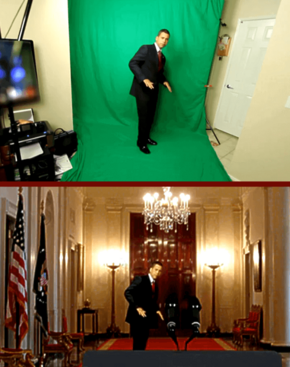
Back مفتاح الكروما Arabic Bluescreen-Technik BAR Син екран (филмова техника) Bulgarian ক্রোমা কি Bengali/Bangla Croma Catalan Barevné klíčování Czech Chroma key Danish Chroma Keying German Croma Spanish Chroma key Basque

Top panel: A frame in a full-motion video shot in the actor's living room.[1]
Bottom panel: The corresponding frame in the final version in which the actor impersonates Barack Obama "appearing" outside the White House's East Room.[2]
Chroma key compositing, or chroma keying, is a visual-effects and post-production technique for compositing (layering) two or more images or video streams together based on color hues (chroma range). The technique has been used in many fields to remove a background from the subject of a photo or video – particularly the newscasting, motion picture, and video game industries. A color range in the foreground footage is made transparent, allowing separately filmed background footage or a static image to be inserted into the scene. The chroma keying technique is commonly used in video production and post-production. This technique is also referred to as color keying, color separation overlay (CSO; primarily by the BBC[3]), or by various terms for specific colour-related variants such as green screen or blue screen; chroma keying can be done with backgrounds of any color that are uniform and distinct, but green and blue backgrounds are more commonly used because they differ most distinctly in hue from any human skin colour. No part of the subject being filmed or photographed may duplicate the color used as the backing, or the part may be erroneously identified as part of the backing.[4]
It is commonly used for live weather forecast broadcasts in which a news presenter is seen standing in front of a CGI map instead of a large blue or green background. Chroma keying is also common in the entertainment industry for visual effects in movies and video games. Rotoscopy may instead be carried out on subjects that are not in front of a green (or blue) screen. Motion tracking can also be used in conjunction with chroma keying, such as to move the background as the subject moves.
- ^ From YouTube video "President Obama on Death of Osama SPOOF- BEHIND THE SCENES" posted to Crosson's secondary YouTube channel "Iman" on 8 May 2011.
- ^ The final (composite) video "President Obama on Death of Osama bin Laden (SPOOF)" posted to Crosson's YouTube channel "Alphacat" on 4 May 2011.
- ^ "What is Chroma Key?". Lumeo. Retrieved 3 July 2014.
- ^ Cite error: The named reference
BorisFXwas invoked but never defined (see the help page).